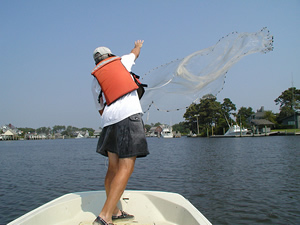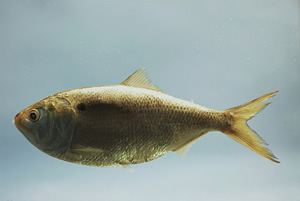How Do I?
- Register with the National Saltwater Angler Registry?
- Find recreational fishing regulations?
- Report a marine mammal or sea turtle stranding?
- Apply for a fishing permit?
- Import/export fishery products?
- Find a Volunteer coastal restoration effort near me?
- Find a catch and landing information for commercial and recreational fisheries?
Scientists to Observe Gulf Menhaden Fishery for Bycatch Impacts
 Menhaden fishing vessels in the Gulf of Mexico
Menhaden fishing vessels in the Gulf of MexicoThis month, the NOAA Fisheries Southeast Fisheries Science Center began placing scientists on the Gulf of Mexico’s menhaden fishing vessels to collect catch data and record bycatch of sea turtles and marine mammals that could interact with the fishery. It’s the latest in a series of new science collection efforts led by the region’s Fisheries Observers Program.
“Observers are highly regarded as the best source on information on fisheries bycatch because they work independently,” said Samantha Brooke, Fisheries Biologist with the National Observer Program. “The scientists are specially trained and the information they collect is always reviewed to ensure its quality.”
The observer programs – used nationwide and to some degree around the world – were started in the 1970’s to help collect scientific data on commercial fisheries. This information is used in stock assessments, management regulations, and in the development of technologies that reduce bycatch.
While on board the fishing vessels, observer biologists will spend
 Casting net for juvenile menhaden.
Casting net for juvenile menhaden. approximately 50 days at sea in the next six months monitoring the Gulf of Mexico’s menhaden fishing fleet to collect catch data on bycatch as it relates to encounters with bottlenose dolphins and sea turtles.
Observers will also collect biological samples for use in growth and aging studies.
Menhaden are small fish found in large shoals that are harvested for use in fish oil and fish meal products. Each year, menhaden accounts for more than $64 million in the Gulf, hauling in about 450,000 tons each year. By sheer volume, this is one of the nation’s largest fisheries.
With such a large fishery playing such a vital role in the Gulf of Mexico, NOAA Fisheries was interested in how fishing for menhaden may impact other marine life, particularly dolphins and sea turtles. It’s been a while since the fishery was observed, but the general perception is that purse seine fishing of menhaden in the Gulf results in very little bycatch. By observing fishing activities through this new effort, the agency will be able to clarify this theory.
“We’re excited to have new information from such an important fishery in the
 Gulf menhaden.
Gulf menhaden.Gulf,” said Brooke. “This science will drive our ability to make decisions to reduce bycatch and adjust our technologies, particularly when protected species are involved.”
The information collected by the observers will improve science on bottlenose dolphin and sea turtle bycatch and help determine mortality estimates for both as it relates to the menhaden fishery.
Under the Magnuson Act, the National Observer Program’s mission is to provide a formal way for the NOAA Fisheries Service to ensure that bycatch is controlled while by providing data necessary to monitor fisheries regulations, such as total allowable catch levels. For nearly 40 years, it’s been one of the best available methods for monitoring fishery performance and complete stock assessments.
For more information on NOAA Fisheries Observer Programs visit: www.st.nmfs.noaa.gov/st4/nop/
NOAA Fisheries Southeast Fisheries Science Center:
http://www.sefsc.noaa.gov/


